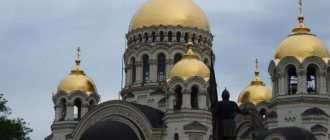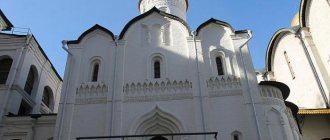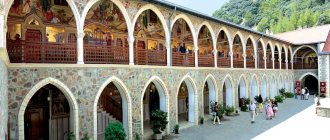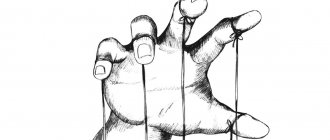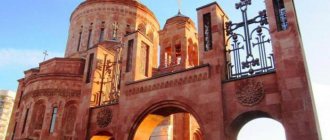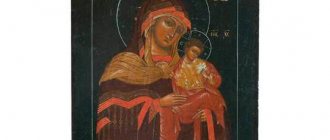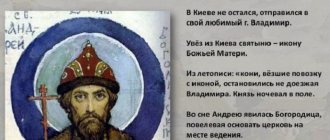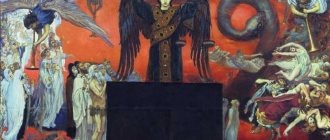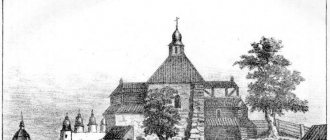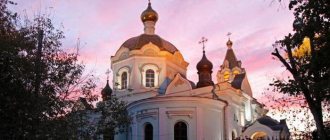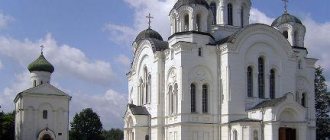Share with family and friends:
People who have heard at least a little about the Seraphim-Diveevo Convent and its shrines think that there are also many miraculous icons here. In fact, in the monastery churches there are all the same images as throughout Russia. And although many of the icons familiar to us, recognized as miraculous in Russia, help those who resort to them in Diveevo, there are few actual Diveevo icons with a special history.
You will also find our rating of hotels and hotels with inexpensive rooms in Diveevo useful.
Icon “Tenderness” in Diveevo
The Icon of the Mother of God “Tenderness” is a fragment of the icon of the Annunciation. This touching image represents the Mother of God at the moment of Her acceptance of the good news of the Archangel Gabriel. Her humility penetrates the very soul of the person praying. It is not surprising that Father Seraphim especially revered the Tenderness icon and prayed in front of it at night. And the elder often anointed those who came to him for advice with oil from a lamp burning in front of his beloved image, and the people received healing.
After the amazing kneeling death of St. Seraphim of Sarov in front of the image of “Tenderness,” the icon was transferred to the Diveyevo Monastery, where it remained in the Trinity Cathedral until the revolution.
Now in the Trinity Cathedral there is an exact copy of the miraculous image. This icon was painted with the priest at the beginning of the 20th century, and it is also miraculous. Every Sunday a special prayer service to the Mother of God is served before her - Paraklis
Meaning and veneration in Orthodoxy
The blessed fools for Christ's sake have always occupied a special place among the numerous holy ascetics. The feat of foolishness required special, rare strength of spirit. The prayers of the blessed old woman protected the Diveyevo Monastery from human enemies. Having lived for more than 30 years at the holy monastery, the holy fool saved many monastic souls from temptations and passions.
Paraskeva Sarovskaya made many predictions. Despite the fact that the instructions were given allegorically, they always came true. She knew every thought of those who addressed her, she gave answers to these thoughts, and not to questions.
Everyone came to the holy old woman - rich, poor, peasants, high-ranking officials. The people went to Paraskeva for advice and reassurance. The blessed one not only predicted the future, but also healed mental and physical ailments. It was Paraskeva, during his visit to the blessed one, who predicted martyrdom for Emperor Nicholas II. The holy elder foresaw a civil war and the destruction of the Church.
"Kazan" icon
The miraculous icon of the Mother of God “Kazan” also has its own interesting history.
In the northern part of Diveevo there is a holy spring in honor of the Kazan icon of the Mother of God. There was a chapel above the spring, in which prayer services were held for some time even after the dispersal of the Seraphim-Diveevsky Monastery. In 1939 the chapel was destroyed. But the Lord showed a miracle - from under the ice of a frozen spring, a local resident raised the Kazan icon of ancient writing.
In Soviet times, it was kept by schema-nun Dominica. She became a witness to many miracles that came from the icon. And when the Seraphim-Diveevsky Monastery reopened, Schema-nun Dominica donated the Kazan Icon to the monastery, where it remains to this day in the Trinity Cathedral.
Icons from the cell of Father Seraphim of Sarov
Three ancient icons, which ended up in the Diveyevo monastery after the death of St. Seraphim of Sarov, are in the Church of the Nativity of the Virgin. In this underground church lie the relics of the venerable Diveyevo wives, the founder of the monastery and mother Alexandra, schema-nun Martha and nun Elena.
After venerating the relics, those who wish can venerate the icons from the cell of Father Seraphim. They are on the left wall in front of the exit, three in a row in ancient frames. The image of the Savior, the Mother of God and John the Baptist. Access to the temple is open from 8.00 to 17.00 daily.
What do they ask the blessed one for?
During her lifetime, Paraskeva Diveevskaya patronized women, offended and innocently convicted people. Therefore, most often the blessed one is asked:
- heal from bodily illness, especially with serious brain disease;
- help conceive and give birth to a healthy child;
- protect from thieves, bandits;
- strengthen faith, resolve spiritual doubts.
Unmarried girls turn to the holy fool with a request to help them find their betrothed. The veneration of Paraskeva Diveevskaya falls on October 5 according to the new calendar (September 22 according to the old calendar).
Iconography of St. Seraphim of Sarov
But since we are talking about icons, we see it necessary to talk about the existing icons of Seraphim of Sarov.
The centenary of the canonization of St. Seraphim of Sarov was awaited in Russia, and preparations were made for celebrations not only in Diveevo and Sarov. In Nizhny Novgorod and even in Moscow in June-December 2003, many events, conferences and exhibitions were held dedicated to the history of the Diveyevo and Sarov monasteries, the spiritual feat of Father Seraphim himself and the historical heritage that has survived to this day. One of these events was exhibitions in Nizhny Novgorod at the N.A. Museum. Dobrolyubov and in Moscow at the Central Museum of Ancient Russian Culture named after. A. Rublev.
So what does the iconography of St. Seraphim of Sarov include?
There are several types of icons depicting one of the most beloved Russian saints.
Orthodox texts
On the days of veneration of Saint Paraskeva and her companions, Pelageya and Mary, prayer chants are read - a troparion and kontakion dedicated to the blessed Diveyevo. You can read them not only on holidays, but also on any other day. Both prayer texts are small and easy to learn by heart.
Troparion
He heard the voice of the Apostle Paul saying: We are fools for Christ's sake, Thy servants, O Christ God, Pelagia, Paraskeva and Maria, who were holy fools on earth for Thy sake; Moreover, we honor their memory and pray to You: Lord, save our souls.
The meaning of the icons of Seraphim of Sarov
- The monk is depicted full-length, dressed in a mantle, stole and armbands, his head is open, surrounded by a halo. In the upper left corner of the icon is the Mother of God on the clouds. The walls of the Sarov Monastery are visible below. The saint’s right hand is pressed to his chest, and in his left hand there are leather rosary-ladders. Sometimes hagiographic scenes are written in the margins of the icon. This is exactly the image that the late Metropolitan Nikolai of Nizhny Novgorod donated to the Kazan Wooden Church opened in 1989 in the village of Diveevo. This icon is located in the Trinity Cathedral on the left side. One of the revered shrines, as it contains the half-mantle of St. Seraphim of Sarov.
- Another type of icon is rarer. On it Seraphim of Sarov is also depicted full-length, but on his head is a kamilavka with a cross, and with his right hand he blesses. Two such images are also located in the Diveyevo monastery in the Trinity and Transfiguration Cathedrals.
- The third type of icon represents a waist-length image of the saint in a mantle, epitrachelion and armbands.
The prototypes of all types of icons were the lifetime portraits of Seraphim of Sarov. The best of them is the work of the artist Serebryakov, completed 5 years before the death of Father Seraphim. The elder is depicted in a mantle, epitrachelion and bristles, his right hand is placed on his heart. The pallor of his face emphasizes his ascetic life, and his eyes are blue and very kind. The hair on the head and beard is gray and thick, but not very long.
But another artist, Dmitry Efstaviev, a graduate of the Academy of Arts, also painted a portrait of the saint during his lifetime. In this portrait, Father Seraphim is dressed in a mantle and stole, but the arms are hidden by the sleeves of his cassock, and in his right hand there is a wooden rosary. The eyes are blue, the hair on the open head is light brown, streaked with gray. This is explained by the fact that the portrait was painted when the monk Seraphim was about 50 years old, and he was not yet that old. The original of this portrait was lost in the second half of the 19th century, but they managed to take a photograph from it. And the photograph of the portrait was an illustration in the first biography of St. Seraphim, published in 1863.
Before the revolution, there was another very interesting portrait of Father Seraphim in the Diveyevo Monastery. On it, the elder was depicted in a mantle and kamilavka, with a staff in his right hand. But the look of the saint’s face was special - it seemed to cover all of Russia with a prophetic gaze. This portrait has a long history of travel.
At the beginning of the 20th century, the spiritual writer Sergei Nilus came to the Diveyevo Monastery and he had the opportunity to write down the story of the wife of the late Nikolai Nikolaevich Motovilov, E. I. Motovilova.
“Now I want to show you,” said Elena Ivanovna, “all my shrine, which I still have. After all, you know what Fr. was to my late husband. Seraphim. Father loved him very much. For a long time my husband begged Fr. Seraphim allowed the portrait to be removed from him, and only after repeated and long-term insistence did Father agree. This is his first portrait that I want to show you - it’s extraordinary: sometimes he looks sternly, and sometimes he smiles, and so affably... You’ll see for yourself!
In Elena Ivanovna’s prayer room, above a small table, on the wall I saw this portrait.
- Look, look, he’s smiling!
- And how he smiles!
The face, directly facing the person entering, smiled with such a smile that the heart brightened, looking at this smile - there was so much goodness, greetings, warmth, unearthly, purely angelic kindness in it. And this smile was not the smile of a frozen portrait: I saw that the face was becoming more and more animated, as if it was blossoming”... (“Great in Small,” St. Petersburg, 1903)
After the death of Elena Ivanovna, from 1910, the portrait of Father was kept by the abbess until the dissolution of the monastery in 1927. Then he was transported to Kyiv, and in 1943 he came to Berlin. Later, traces of the miraculous portrait were discovered in North America, in the Novo-Diveevo convent.
In addition to icons and the famous lifetime portraits of Father Seraphim, there were many paintings and hagiographic images painted by both artists and simple peasants. This is how much the people revered the Holy Elder Seraphim.
So the peasant Efim Vasiliev, 11 years after the death of the saint, painted a picture where Father Seraphim fed a bear. In the 40s of the 19th century, a picture appeared that touched me to tears. The bent Father Seraphim walks through the Sarov Forest leaning on a staff with a knapsack over his shoulders.
In 1849, the draftsman Borel created a lithograph depicting the death of an old man. The ascetic fell to his knees in front of the icon of the Mother of God “Tenderness” with his hands folded on his chest.
The painting “Praying on the Stone” is also famous among the people. One of them was painted by priest Leonid Mikhailovich Chichagov (the future Vladyka Seraphim), who wrote the chronicle of the Seraphim-Diveevo Monastery.” Nowadays this painting is in one of the Moscow churches.
Until now, the history of the iconography of St. Seraphim of Sarov has not been completed. The 20th century gave birth to a new wave of paintings and images created by artists and icon painters around the world. Touching popular love for the holy Venerable Seraphim of Sarov and his spiritual feat inspires the hearts of people.
How to venerate icons?
- One must approach icons reverently. Place the sign of the cross on yourself, bow down, ask in mental prayer for help from the Lord, the Mother of God or the saint whose icon you want to venerate. Then touch the frame or frame with your lips (it is not advisable to kiss glass, marks will remain on it, but if this happens, do not be upset - there is nothing wrong with that).
- After kissing the icon, cross yourself again and bow.
- If you have a special request, and there is a line to see the icon, do not delay people. Venerate the holy image at the time allotted to you, and then stand nearby and pray silently to yourself as long as necessary.
- Typically, although not always, there are candlesticks in front of the icons where you can light your candle.
- For women! Before kissing the icon, make sure that there is no lipstick left on your lips. If in doubt, it is better to blot your lips with a napkin so as not to leave traces of makeup on the icon.
Tatyana Strakhova
no comments
